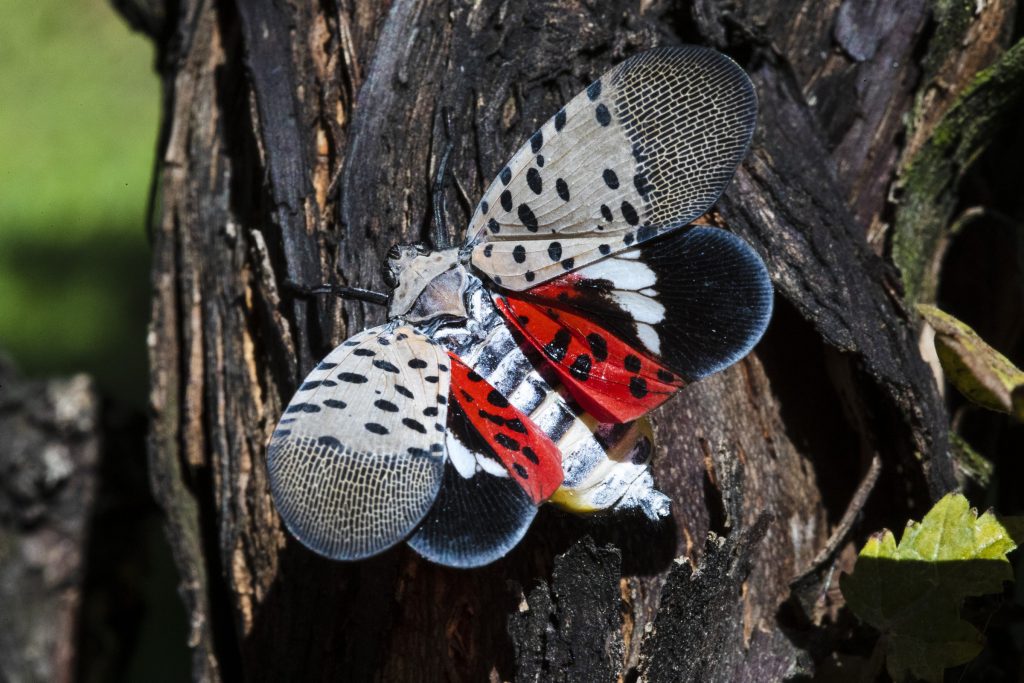The state Department of Agriculture has added Luzerne County to its list of counties under quarantine for spotted lanternfly, an invasive species of insect that is spreading across the state.
The quarantine impacts businesses that transport produce or goods out of Luzerne County, according to Agriculture Department spokeswoman Shannon Powers. Business owners will be required to obtain a lanternfly permit, after taking an online course that explains how to keep the infestation from spreading, she said.
According to Powers, spotted lanternflies have been reported in five county municipalities: Wilkes-Barre city, Wilkes-Barre Twp., Hanover Twp., Dennison Twp. and Dupont.
The spotted lanternfly is native to Asia. It was first found in the United States in 2014, in Berks County. Since then, lanternfly sightings have been reported across eastern Pennsylvania and neighboring states.
Some local companies already have permits, including A&A Carting of Hazleton, where Jude Lonzetta said he hasn’t seen any lanternflies.
Carbon and Schuylkill counties came under the quarantine earlier so businesses and agencies already obtained permits.
Banks Twp. in Carbon County took out permits so road crews could drive to Eckley and Dorrance Twp. in Luzerne County to pick up stone, tar and other road materials.
Supervisor Charles Schalles said he had to take an online course from Penn State Extension. Then he trained three employees to recognize the life cycles of the lanternfly and tell them what to do if they spot one.
The course advises against parking under trees, for example, so lanternflies are less likely to latch on to a vehicle and tells drivers to look for lanternflies before each trip.
Schalles said he only has seen one lanternfly, in an alley of the township. “I don’t know if it came off a truck,” he said.
Lanternflies feed on the sap of fruit trees and excrete a sticky fluid that coats leaves and branches.
While the insects do not pose a public health risk, they can impact the quality of life of people who live in an infested area.
“The nuisance factor is high,” Powers said. “You wouldn’t want it where you live.”
The quarantine designation will not impact the day-to-day life of most county residents, but the Agriculture Department wants citizens to be on the lookout for lanternfly egg masses, Powers said.
Egg masses look like “a smear of mud,” she said.
Destroying those egg masses can prevent 30 to 40 lanternflies from hatching, according to Powers.
“What we really are trying to do is get people to pay attention,” Powers said.
Secretary of Agriculture Russell Redding urged everyone to “keep their eyes peeled for signs of this bad bug.”
“We need every Pennsylvanian … to scrape every egg mass, squash every bug, and report every sighting,” Redding said in a statement. “We need to unite over our hatred for this pest for our common love: Pennsylvania.”
Egg masses can be found throughout areas of infestation, including unexpected places such as lawn furniture, Powers said.
Lanternflies also pose a threat to the state’s economy, according to Powers.
She cited a study conducted by Penn State’s College of Agricultural Sciences that suggested the spotted lanternfly could cost 2,800 jobs statewide in businesses impacted by the infestation.
Total economic damage from the infestation could be at least $324 million, including crop destruction, according to that study.
The Agriculture Department expanded the state quarantine list by 12 counties on Tuesday, in advance of the spring hatch in late April and May.
Kent Jackson, staff writer, contributed to this story.
Look for lanternflies
September-May
Egg masses resemble white or gray mold on tree bark or masonry.
What to do: scrape the eggs into container with alcohol.
April-October
Nymphs, black crawlers with six legs and white spots, begin to move and jump around. Their body turns red as they mature.
What to do: Place tape from a garden center, sticky side out, around a tree. Nymphs will get stuck on the tape.
July-November
Adults that look like moths with sets of wings, which are mostly white with black spots. The back wings, however, are red and the head and neck take on a blue tint.
Also, Tree-of-Heaven are primary hosts for lanternflies and can be cut down. Apply herbicide to the tree between July and September and wait a month before cutting. Otherwise, new growth will come from the stump.
SOURCE: PENN STATE EXTENSION

